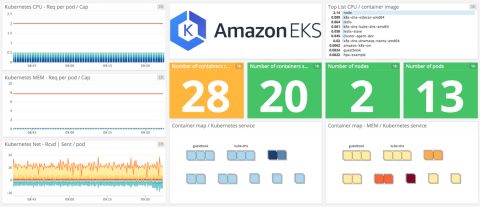Operations | Monitoring | ITSM | DevOps | Cloud
%term
Monitor Amazon EKS with Datadog
Amazon Elastic Container Service for Kubernetes (EKS), the latest addition to the AWS platform, is a cloud-based Kubernetes service that provides features for automated cluster management and maintenance. Whether you are migrating an existing Kubernetes cluster or deploying a new application to Amazon EKS, Datadog can help you monitor your container infrastructure and applications in real time.
Elasticsearch Performance Tuning
Once you have your Elasticsearch running, you’ll likely eventually find that performance starts to suffer over time. This can be due to a variety of factors, including changes in the way you’re using your cluster to how much and what types of data are being sent in. In order to maintain your cluster, you’ll need to set up monitors to alert you to any warning signs so that you can proactively handle available maintenance windows.
New Release: Public Status Page | Breakdown and Use Case
Uptime Status Pages can now be shared publicly. You will find that they are a useful tool for information sharing under a variety of circumstances. Internal pages offer excellent insight for your team, but public status pages provide users and other parties helpful information about your services and websites.
Q&A with Oleg and Terry: Interfaces into advanced scheduling in Kubernetes
Q&A with Oleg and Terry: Factors Kubernetes considers when scheduling pods and nodes
Opsgenie
4 Ways the New York Times and Sentry Simplify their Tech
I recently spoke to Nick Rockwell, CTO at The New York Times (a Sentry customer), and Yonas Beshawred of Stackshare about simple solutions, React, and going serverless. Take a listen or read on for the highlights. Because why would we even bother with the lowlights?
Using Trend Analysis for Better Insights
Centralized log collection has become a necessity for many organizations. Much of the data we need to run our operations and secure our environments comes from the logs generated by our devices and applications. Centralizing these logs creates a large repository of data that we can query to enable various types of analysis. The most common types are conditional analysis and trend analysis. They both have their place, but trend analysis is perhaps the more often underutilized source of information.
Log Management Comparison: ELK vs Graylog
Production logs can help ensure application security, reveal business insights and find and understand errors, crashes, and exceptions. But as useful as logs are, they’re difficult to manage and hard to keep track of. Making matters worse is that as log data volume grows, so does the difficult task of maintaining and managing them. It’s for this reason that developers, DevOps engineers, and CTOs turn to log management tools.











